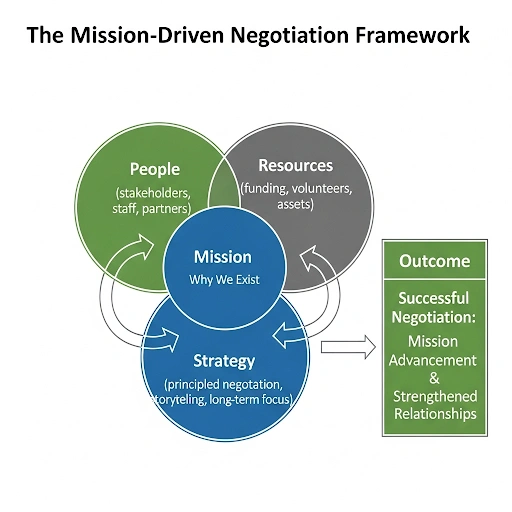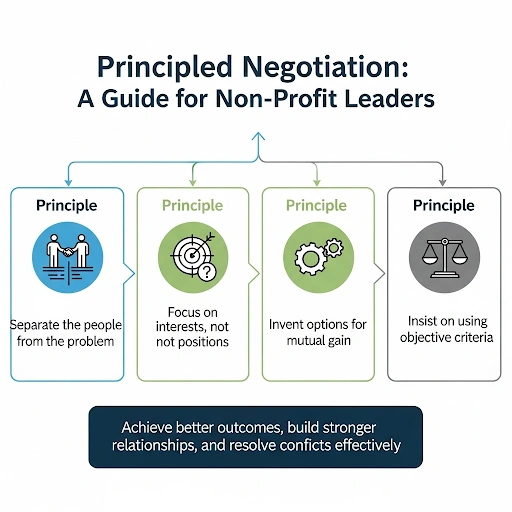Imagine this: you’re sitting across the table from a potential corporate sponsor, a major grant funder, or even a venue manager offering a space for your annual gala. You know the value your organization brings to the community, and negotiation techniques non-profit professionals often use can turn that value into real commitments. With these negotiation techniques for non-profit professionals, your passion, data, and stories gain stronger influence. Success here is less about pressure and more about negotiation techniques non-profit professionals rely on to build trust. In truth, these negotiation techniques tailored for non-profit professionals define whether you leave with support or missed chances.
- What are Mission Driven Negotiation Techniques Non-profit Professionals?
- Why Mastering Negotiation Matters for Your Non-Profit
- How It Works: The Core Framework of Principled Negotiation
- Negotiating a Corporate Sponsorship
- Comparison: Collaborative vs. Competitive Negotiation
- Common Mistakes Non-Profit Negotiators Make
- Expert Tips and Best Practices
- Frequently Asked Questions (FAQ)
- Conclusion
What are Mission Driven Negotiation Techniques Non-profit Professionals?
In the for-profit sector, negotiation often centers on a singular goal: maximizing financial gain. For non-profits, the calculus is different, and here negotiation techniques non-profit professionals apply bring another dimension. Mission-driven negotiation is an approach rooted in values, and negotiation techniques for non-profit professionals ensure that purpose always guides the process. It’s not about “winning” a battle; rather, negotiation techniques non-profit professionals depend on turn dialogue into collaboration. At its core, these negotiation techniques designed for non-profit professionals protect both mission and relationships.
In 2025, as the non-profit landscape becomes increasingly competitive and complex, these skills are no longer optional. Negotiation techniques non-profit professionals rely on are now essential to navigate new challenges. Donors are more discerning, which makes negotiation techniques for non-profit professionals critical in presenting value with clarity. The demand for measurable impact is higher, and negotiation techniques non-profit professionals practice can transform expectations into collaboration. In this shifting environment, negotiation techniques used by non-profit professionals help organizations stay both resilient and relevant.

Why Mastering Negotiation Matters for Your Non-Profit
Learning and applying effective negotiation skills can be a game-changer for your organization’s health and sustainability. When practiced intentionally, negotiation techniques non-profit professionals use every day help turn challenges into opportunities. These negotiation techniques for non-profit professionals are not about pressure, but about creating alignment. By applying negotiation techniques non-profit professionals refine through experience, even small wins can support long-term stability. In truth, negotiation techniques trusted by non-profit professionals are what transform ordinary discussions into lasting progress.
Securing More Funding and Better Grants
Strong negotiation allows you to move beyond the standard grant agreement. With negotiation techniques non-profit professionals often apply, it’s possible to secure full cost coverage, including essential overhead. These negotiation techniques for non-profit professionals make it easier to frame discussions around fair and sustainable terms. By using negotiation techniques non-profit professionals rely on, you can also manage cash flow through better payment schedules. In practice, negotiation techniques designed for non-profit professionals create agreements that reflect the real needs of your programs.
Building Stronger, More Collaborative Partnerships
The best partnerships are built on a clear understanding of mutual value. Whether you’re collaborating with another non-profit, a government agency, or a corporation, negotiation helps you define roles, responsibilities, and shared goals. This clarity prevents future misunderstandings and builds a foundation of trust, leading to long-term, resilient alliances that can achieve more together than you ever could apart. You can learn more in our guide to non-profit financial stewardship.
Optimizing Resources and Reducing Costs
Every dollar saved is a dollar that can be redirected to your mission. From negotiating better rates with software vendors and event suppliers to securing pro bono services from professional firms, strategic negotiation helps you become a more effective steward of your resources. It’s about ensuring you get the best possible value, allowing you to maximize your program delivery and operational efficiency.
Enhancing Your Organization’s Reputation and Influence
When you negotiate with confidence and integrity, you signal that your organization is professional, strategic, and well-managed. This enhances your reputation among funders, partners, and the community. It positions you as a leader in your field, one who is not just asking for help but is actively building solutions and inviting others to be part of that success.
How It Works: The Core Framework of Principled Negotiation
One of the most effective models for mission-driven negotiation comes from the work of Roger Fisher and William Ury in their seminal book, Getting to Yes. Within this approach, negotiation techniques non-profit professionals can adopt are grounded in fairness and clarity. Their framework, known as “Principled Negotiation,” reflects negotiation techniques for non-profit professionals that emphasize collaboration over competition. It’s a method that aligns well with negotiation techniques non-profit professionals depend on to balance mission with partnership. In practice, these negotiation techniques tailored for non-profit professionals create solutions that serve both sides with integrity.
- Separate the People from the Problem: In any negotiation, emotions can run high. It’s easy to see the person on the other side of the table as an adversary. This principle urges you to treat them as a partner in solving a shared problem. Focus on the issue at hand, not on personalities.
- Focus on Interests, Not Positions: A “position” is what someone says they want (“We need a $50,000 sponsorship”). An “interest” is why they want it (“We need to fund our summer reading program for 200 children”). When you understand their interests and share your own, you can find creative solutions that meet everyone’s needs.
- Invent Options for Mutual Gain: This is the brainstorming phase. Instead of locking into a single solution, work together to generate a wide range of possibilities. The goal is to expand the pie before you divide it.
- Insist on Using Objective Criteria: To ensure the agreement is fair and sustainable, base it on objective, external standards like market rates or legal precedent. This depersonalizes the discussion and protects the relationship.

Negotiating a Corporate Sponsorship
She wants to secure a major sponsorship for their annual career conference from a local tech company, Innovate Corp. To prepare, Sarah studies negotiation techniques non-profit professionals rely on to strengthen partnerships. She adapts negotiation techniques for non-profit professionals to frame the conference as a shared investment, not just a request. With negotiation techniques non-profit professionals value, she transforms the discussion into an opportunity for collaboration. Ultimately, these negotiation techniques tailored for non-profit professionals help her demonstrate that supporting the initiative benefits both the youth and the company.
Preparation (Interests & Criteria):
She also discovers they are actively trying to recruit diverse, local talent. This becomes a key interest, and negotiation techniques non-profit professionals refine allow her to link it with student needs. By using negotiation techniques for non-profit professionals, Sarah positions career pathways as part of the sponsorship conversation. These negotiation techniques non-profit professionals embrace make it easier to show impact beyond financial support. Ultimately, negotiation techniques trusted by non-profit professionals allow her to present funding and opportunities as one shared solution.
The Meeting (People & Options):
In the meeting, Sarah doesn’t lead with a hard ask. She starts by asking about Innovate Corp’s community engagement goals. She listens intently. When she presents, she frames the sponsorship not as a donation, but as a partnership to help them meet their recruitment and CSR goals. She presents a tiered proposal:
- Tier 1: A standard financial sponsorship with logo placement.
- Tier 2: A reduced financial sponsorship, plus Innovate Corp engineers hosting a “Coding 101” workshop.
- Tier 3: A “Talent Pipeline” partnership, where Innovate Corp provides paid internships for top students.
By focusing on their interests and providing creative options, Sarah transforms the conversation. They ultimately agree on a hybrid of Tiers 2 and 3, an outcome far more valuable to her mission than cash alone.
Comparison: Collaborative vs. Competitive Negotiation
| Feature | Collaborative (Win-Win) | Competitive (Win-Lose) |
|---|---|---|
| Goal | Create mutual value; find a fair solution for all. | Maximize own gain; “win” as much as possible. |
| Mindset | “How can we expand the pie?” | “How can I get the biggest slice of the pie?” |
| Outcome | A sustainable, long-term relationship is built. | The relationship may be damaged or transactional. |
| When to Use | Ideal for donors, partners, staff, and key vendors. | Rarely advisable; may be encountered with one-off vendors. |
Common Mistakes Non-Profit Negotiators Make
1. The “Charity Mindset” (Apologizing for Asking)
Avoid it by: Framing your ask with confidence. You are offering an opportunity to invest in community impact. You are a partner, not a petitioner.
2. Focusing Only on Price/Money
Avoid it by: Brainstorming non-monetary items before you negotiate, like longer payment terms, public recognition, or volunteer support.
3. Not Knowing Your BATNA
Avoid it by: Clearly identifying your Best Alternative To a Negotiated Agreement before you enter the room. This is your walk-away plan and your source of power.
4. Forgetting to Listen
Avoid it by: Following the 80/20 rule. Aim to listen 80% of the time and talk 20% of the time. Ask open-ended questions to understand their interests.
Expert Tips and Best Practices
- Anchor Your Ask High (But Realistically): The first number put on the table has a powerful psychological effect. Start with an ambitious but credible proposal to give yourself room to concede.
- Leverage the Power of Storytelling: Data is important, but emotion moves people to act. Weave compelling stories about your impact into the conversation.
- Frame Everything Around Impact: Instead of saying, “We need $10,000,” say, “A $10,000 investment will provide 500 hot meals to homeless veterans this winter.”
- Practice, Practice, Practice: Role-play upcoming negotiations with a colleague. The more you practice, the more confident you will become.

Frequently Asked Questions (FAQ)
Q: How can I negotiate when I feel like I have very little leverage?
A: Your mission is your leverage. You offer partners a unique value proposition: the ability to make a tangible, positive impact on the community. Your network, community trust, and stories are all forms of leverage.
Q: What’s the difference between negotiation and haggling?
A: Haggling is competitive and focused on a single issue (usually price). Negotiation is a collaborative process focused on understanding interests and creating broad, sustainable value for all parties.
Q: Is it okay to say “no” to a potential donor or partner?
A: Absolutely. Accepting a partnership that compromises your mission or strains your resources can be more damaging than having no funding at all. Knowing your BATNA gives you the power to walk away gracefully.
Q: What are some good books to learn negotiation skills?
A: Getting to Yes by Roger Fisher and William Ury is the essential starting point. Never Split the Difference by Chris Voss and Bargaining for Advantage by G. Richard Shell are also excellent guides.
